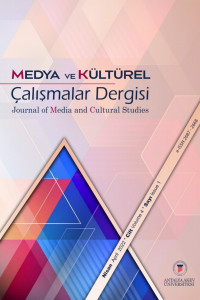SANAL DÜNYANIN GÖRGÜ KURALLARI: NETİKET
Sosyal bir varlık olan insan, oluşturduğu her grupta normlar geliştirir ve grubun her üyesinden bu normlara uyması beklenir. Yeni medya mecralarının kullanım alanları ve kullanım süreleri arttıkça sanal dünya bir sosyal ortama dönüşmüş ve burada yeni normlar oluşmaya başlamıştır. Sosyal medya kullanıcıları, artık çoğunlukla kendi isimlerini kullanarak hesap açmakta ve çevrimiçi aktivitelerde bulunmaktadır. Özellikle yeni medya mecraları iletişim amaçlı olarak kullanıldığında sosyal mekân gibi algılanmakta ve buradaki iletişimi bir düzen içerisine sokan görgü kurallarına ihtiyaç duyulmaktadır. Netiket olarak adlandırılan internetteki görgü kuralları, özellikle Türkiye’de yeni medya çalışmalarında yeterince çalışılmayan bir konudur. Bu çalışmada netiket kavramının oluşumu ve dijital ayak izi ve dijital itibar ile ilişkisi tartışılmıştır. Çalışma netiketin gerekliliğini ve başlıca netiket öğelerini gündeme getirmesi bakımından alana katkı sağlamayı amaçlamaktadır.
Anahtar Kelimeler:
Netiket, Sosyal medya ve toplum, Dijital ayakizi, Dijital İtibar, Görgü kuralları
Etiquette of CyberSpace: Netiquette
Human beings are social creatures and form social norms in every group they are involved in. As the usage of new media platforms vary and the amount of time spent on new media increased, the cyber world has turned into a social space and formed its own social norms. Social media users are creating their accounts with their real names and their online activities are non-anonymous. When new media platforms are used to communicate with each other, they are perceived as a social space and a need for rules of good manners rises. Netiquette: good manners for new media platforms is a new concept in Turkish New media academia and is rarely studied. This study aims to discuss formation of netiquette and its relationship with digital footprints and digital reputation. This study is important as it discusses the necessity of netiquette and expresses the fundamental netiquette rules.
___
- Aggarwal, A. K. (2014). Netiquette in E-Learning. Proceedings for the Northeast Region Decision Sciences Institute (NEDSI). 181-182.
- Atalay, G.E. (2019). Netiquette in Online Communications: Youth Attitudes Towards Netiquette Rules on New Media. A. Ayhan (Ed.). New Approaches in Media and Communication içinde (s.225-238). Berlin: Peter Lang.
- Brandtzaeg, P.B. ve Lüders, M. (2018). Time Collapse in Social Media: Extending the Context Collapse. Social Media +Society. January- March. 1-10.
- Brusco, J. M. (2011). Know Your Netiquette. AORN Journal, 94 (3). 279-286.
- Etiquette (t.y.). Cambridge Dictionary Erişim adresi www.dictionary.cambridge.org/dictionary/english/etiquette
- Etik (t.y). Türk Dil Kurumu Sözlükleri. Erişim adresi https://sozluk.gov.tr/
- Giddens, A. (2005). Sosyoloji. Ankara: Ayraç Yayınları.
- Goffman, E. (1959). The Presentation of Self in Everyday Life. Garden City, Nj: Doubleday
- Goffman, E. (2017). Etkileşim Ritüeleri: Yüz yüze Davranış Üzerine Denemeler. (A. Bölükbaşı, Çev.) Ankara: Heretik.
- Hammond, L. ve Moseley, K. (2018). Reeling in Proper “Netiquette”. Nursing made Incredibly Easy! March/April. 50-53.
- Hearn, A. (2010). Structuring feeling: Web 2.0, online ranking and rating, and the digital ‘reputation’ economy. Ephemera: Theory & Politics in Organization. 10(¾): 421-438.
- Kağıtçıbaşı, Ç ve Cemalcılar Z. (2016). Dünden Bugüne İnsan ve İnsanlar: Sosyal Psikolojiye Giriş. 18. Basım, İstanbul: Evrim Yayınevi.
- Khamis, S., Ang, L. ve Welling, R. (2017). Self-branding, ‘micro-celebrity’ and the rise of Social Media Influencers, Celebrity Studies, 8(2), 191-208.
- Kozik, T. ve Slivova, J. (2014). Netiquette in Electronic Communication. International Journal of Engineering Pedagogy. 4(3). 67-70.
- Kurt, M ve Teker N. (2017). Öğretmen adaylarının Net-etik davranışlarının belirlenmesi. Bartın Üniversitesi Eğitim Fakültesi Dergisi. 6 (2). 749-769.
- Madden, M. ve Smith, A. (2010). Reputation management and social media: How people monitor their identity and search for other online. https://www.pewinternet.org/2010/05/26/reputation-management-and-social-media/ adresinden ulaşılmıştır.
- McCulloch, G. (2019). Because Internet: Understanding the New Rules of Language. NewYork: Riverhead Books.
- Micheli, M., Lutz, C. ve Büchi, M. (2018). Digital footprints: an emerging dimension of digital inequality. Journal of Information, Communication and Ethics in Society, 16( 3). 242-251.
- Ozankaya, Ö. (1996). Toplumbilim. 9. Basım, İstanbul: Cem Yayınevi.
- Scheuermann, L. ve Taylor, G. (1997). “Netiquette”, Internet Research, 7(4), pp. 269–273.
- Shapiro, Z. ve Anderson, R. H. (1985). Towards an Ethics and Etiquette for Electronic Mail. Santa Monica: Rand Corporation.
- Steinberg, S. (2017). Social Network Etiquette: New Rules for Minding your Manners in a Digital World. Toastmaster, June 1. 14-15.
- Digital 2019 Global Overview Report (2019), We are Social. Erişim adresi https://wearesocial.com/global-digital-report-2019
- Williams, V. (2017). Etiquette and Taboos Around the World (Ed. Taylor E. Williams V.) içinde Introduction, Greenwood, California.
- Yayın Aralığı: Yılda 2 Sayı
- Başlangıç: 2019
- Yayıncı: Antalya Akev Üniversitesi
